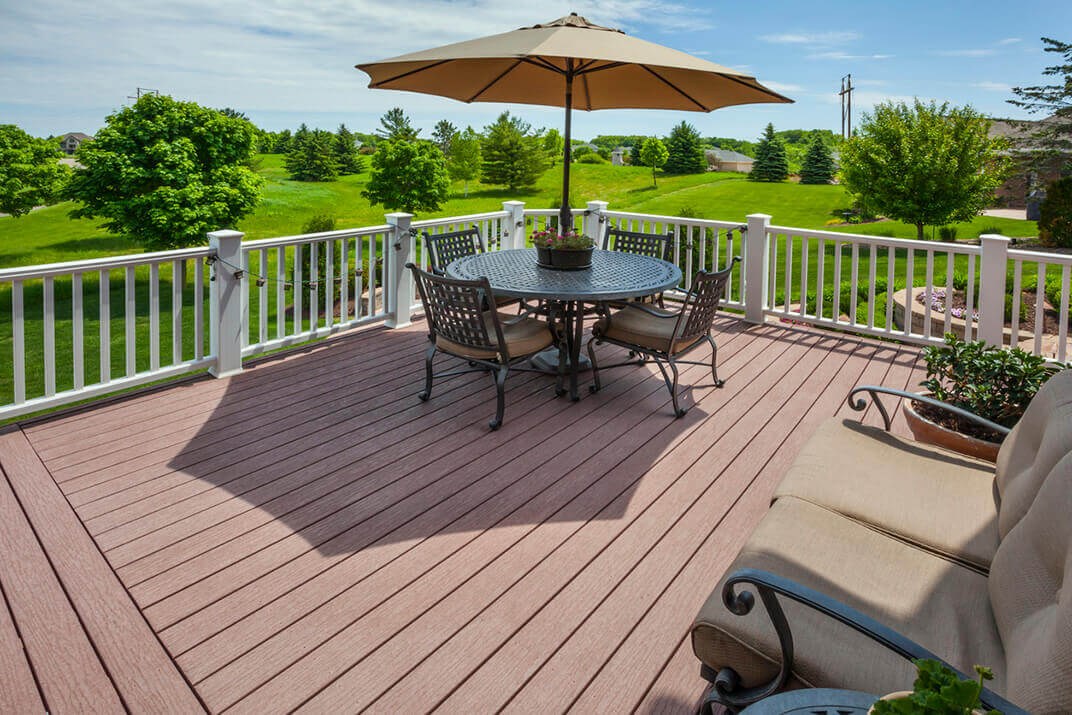
When it’s time for a new deck, you have a choice: traditional wood or composite. There are solid arguments on both sides, but the discussion can get a bit contentious when partisans are involved. To make the right decision for your deck, you must be informed. That’s why we here at J&W Lumber are hosting a debate between Team Composite and Team Wood. Without further ado, we bring you The Great Deck Debate.
J&W Lumber Moderator: Welcome to tonight’s debate. After our frank discussion, we hope you’ll have learned critical information and are prepared to decide which material is right for you. Let’s introduce our debaters.
Representing wood is carpenter and longtime lumber advocate Natalie Wood. Representing composite material is general contractor and one of the most outspoken supporters of composite decks, John Composite.
Each candidate will now make a short opening statement. Ms. Wood, the floor is yours.
Wood: My fellow homeowners, our country was built on the strength and beauty of wood. In fact, human civilization would not be possible without wood. Wood has built our shelters, our boats, and our transportation. It’s given us warmth on cold nights. It’s environmentally friendly, sustainable, and entirely renewable. From the solid oaks of the east to the swaying palms of the south to the majestic Redwoods of the west, wood is the foundation our country – and the lifeblood of our society. When it comes to decks, there is no better option than wood.
Moderator: Mr. Composite, it’s your turn.
Composite: Ladies and gentleman, it is time for a change. It’s time for real progress. The ingenuity of the American people has helped create materials that allow us to build gorgeous decks that far surpass the traditional wood deck in longevity, reliability, and ease of use. While I agree with Ms. Wood about the impact wood has had on our great country, I ask you to look forward, not back, when considering which material to build your deck with.
Moderator: Mr. Composite, you’ve said that composite decks are superior when it comes to longevity, can you expand on that?
Composite: Sure. It’s simple – composite materials don’t rot! Once you build a composite deck, you won’t have to replace it for a very long time. Trex offers a 25-year warranty on its decking products. Composite decks stand up to every element – including rain, sun, heat, cold – you name it. Composite decks are also completely resistant to insects, which can spell doom for wood. With composite decks, you’ll never need to worry about splinters or splits. You’ll enjoy the kind of longevity that we could only dream about 30 years ago.
Moderator: Ms. Wood, your rebuttal?
Wood: My opponent seems to have conveniently forgotten the natural resilience of wood. Take the Redwood tree – a popular wood for building decks. Redwoods live for 2000 years! While wood does eventually rot, trees have built up a natural resistance that applies to decks as well. Using pressure-treated lumber will help eliminate the threat of both rot and insects, allowing your deck to survive and thrive for decades, if not longer.
Moderator: Many Americans make their choice of deck based on personal style. Ms. Wood, what can people expect from wood in terms of style?
Wood: Glad you asked. Styles of wood vary as much as the trees they come from. Whatever your style preference, you’ll find a wood that’s right for your deck. Woods come in a variety of shades and density, and can be stained to match any color you prefer. Personally, I favor California Redwood. It’s strong and durable, it has a natural beauty, and undeniable warmth and character.
Of course, Redwood is just one choice among many. If you prefer a truly high-end deck that will be the talk of the town, hardwoods like Mangaris from Indonesia and Ipe from Brazil offer an upscale, beautiful, and durable decking solution. With wood, you can both see and feel the beauty under your feet.
Moderator: Mr. Composite?
Composite: If you like a particular style of wood, composite materials can replicate it down to the exact look. Redwood, Cedar, hardwoods – it doesn’t matter. Composites give you all the beauty of wood – without the complications. What’s more, composites come in a variety of colors. Composite decks are also more flexible when it comes to shapes. They can be molded and bent to create seamless curves that wood can’t achieve. In fact, our mutual friends at J&W Lumber have the only Trex bending machine in Southern California, which can shape any composite board to your personal specifications. Composites offer more of what you already love. It’s a simple choice in my mind.
Moderator: Many homeowners are busy people. They have families, jobs, social engagements, and more. Could each of you talk about the maintenance required for wood and composites?
Composite: When it comes to ease of maintenance, composite decks are far and away the better choice – and I think even my opponent would admit that. With zero rot, fading, twisting, or decay, there’s never a need to refinish or re-stain composite decking. The only maintenance required for a composite deck is a hose and soapy water. You’ll basically just be washing off dust and grime – not exactly formidable enemies.
Wood: It’s true – wood does require some maintenance. But it’s not like you’ll need to refinish your deck every year. Your deck is a living, breathing structure and should be treated as such. And there’s nothing wrong with a little elbow grease when it comes to one of your prized possessions. Hard work gives you a real appreciation for your deck.
Moderator: As both of you know, cost is often the first thing on the minds of homeowners. Mr. Composite, many people believe that composite decking is out of their price range.
Composite: Thank you for bringing this up. Composite decking has been wrongly labeled as “expensive” in the main stream media, and it’s simply not true. Ten years ago, when composite decking was in its infancy, it was more expensive. But as technology has advanced, and composite has become more popular, prices have dropped significantly. It’s like flat screen TVs. When they were first introduced, they were very expensive. But today, they’re affordable by just about any standard.
Wood: It’s true, the prices of composites have come down. But wood is still the more affordable option. I would also caution homeowners about quality. Don’t just look at price tags, look at what you’re getting. There are multiple levels of quality. Don’t be fooled by cheap imitators.
Moderator: OK, you’ve both made some great points. Before we end this debate, I’d like each of you to give me five final bullets that describe how your option is the best choice.
Wood:
- Traditional
- Unique
- Environmentally Friendly
- Sturdy
- Beautiful
Composite:
- Innovative
- Maintenance Free
- Flexible
- Long Lasting
- Beautiful
Moderator: Well, there you have it, folks. I hope you enjoyed tonight’s debate, and I hope you learned important information on your options for decking. If you have additional questions or want to learn more, contact J&W Lumber or visit one of our showrooms today!
